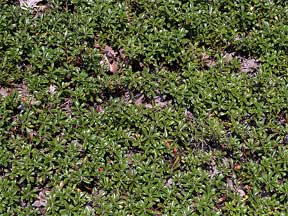A list of groundcovers and vines for the cold Northern States:
BEARBERRY—One of the best ground covers for dry, difficult situations, this low plant, which is known scientifically as Arctostaphylos Uva-ursi is ideal for steep slopes. It grows in sun or partial shade and prefers a dry sandy soil somewhat on the acid side. Its broad leaves are a good green the year round.
COMMON PERIWINKLE – Large areas can be beautifully carpeted with this plant known as Vinca minor. Use it under trees and in other shady locations in any ordinary soil. It grows 6 to 8 inches high and has light blue flowers in early spring. In this cold region it may winter burn if not covered by deep snow.
CREEPING JUNIPER – This needled evergreen makes a fine ground cover to one foot high in sunny locations. It will grow in any soil but prefers one of a rocky nature. It is listed as Juniperus horizontalis and its variety Douglasi is especially interesting for its blue cast.

PARTRIDGE-BERRY – For small areas Mitchella repens, as this plant is known, makes a fine cover growing less than an inch high. It prefers some shade and a dry to moist acid soil. The shiny leaves are green all winter, and the plant is noteworthy for its persistent bright crimson fruits.
WINTERGREEN – The highly aromatic leaves of this native plant called Gaultheria procumbens are green the year round. Use it for a cover in shaded locations where the soil is acid and well drained.
WINTERCREEPER – Euonymus Fortune radicans makes a carpet a foot or so thigh, and is recommended for use in the more temperate parts of the area or in sections assured of good snow cover. It will thrive in any ordinary soil in sun or shade.
TRAILING ARBUTUS – Only about 4 inches tall, this low trailing plant called Epigaen repens makes a fine ground cover when established from nursery-grown plants. It has pale pink flowers in spring and is especially adaptable for covering small shaded areas. It prefers a highly acid soil.
RUNNING-PINE – This plant gives a handsome show in shaded areas. While it never grows more than 4 inches tall, its running stems stretch out 10 feet or more. It is called Lycopodium clavatum and may be collected from the wild or purchased from a nursery which specializes in native plants.
